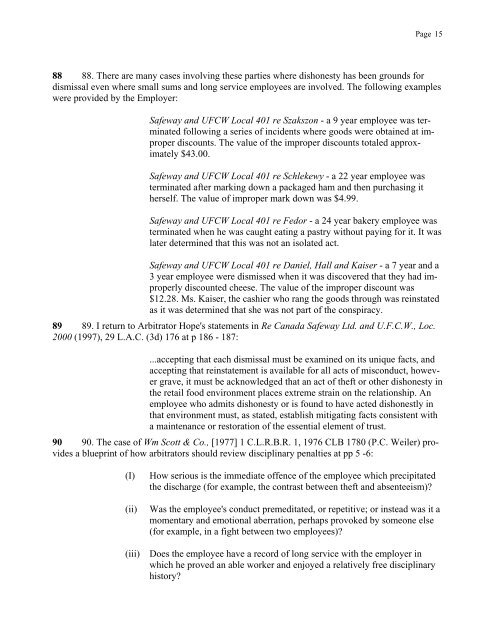FAQ's Cases - Stewart McKelvey
FAQ's Cases - Stewart McKelvey
FAQ's Cases - Stewart McKelvey
- No tags were found...
You also want an ePaper? Increase the reach of your titles
YUMPU automatically turns print PDFs into web optimized ePapers that Google loves.
Page 1588 88. There are many cases involving these parties where dishonesty has been grounds fordismissal even where small sums and long service employees are involved. The following exampleswere provided by the Employer:Safeway and UFCW Local 401 re Szakszon - a 9 year employee was terminatedfollowing a series of incidents where goods were obtained at improperdiscounts. The value of the improper discounts totaled approximately$43.00.Safeway and UFCW Local 401 re Schlekewy - a 22 year employee wasterminated after marking down a packaged ham and then purchasing itherself. The value of improper mark down was $4.99.Safeway and UFCW Local 401 re Fedor - a 24 year bakery employee wasterminated when he was caught eating a pastry without paying for it. It waslater determined that this was not an isolated act.Safeway and UFCW Local 401 re Daniel, Hall and Kaiser - a 7 year and a3 year employee were dismissed when it was discovered that they had improperlydiscounted cheese. The value of the improper discount was$12.28. Ms. Kaiser, the cashier who rang the goods through was reinstatedas it was determined that she was not part of the conspiracy.89 89. I return to Arbitrator Hope's statements in Re Canada Safeway Ltd. and U.F.C.W., Loc.2000 (1997), 29 L.A.C. (3d) 176 at p 186 - 187:...accepting that each dismissal must be examined on its unique facts, andaccepting that reinstatement is available for all acts of misconduct, howevergrave, it must be acknowledged that an act of theft or other dishonesty inthe retail food environment places extreme strain on the relationship. Anemployee who admits dishonesty or is found to have acted dishonestly inthat environment must, as stated, establish mitigating facts consistent witha maintenance or restoration of the essential element of trust.90 90. The case of Wm Scott & Co., [1977] 1 C.L.R.B.R. 1, 1976 CLB 1780 (P.C. Weiler) providesa blueprint of how arbitrators should review disciplinary penalties at pp 5 -6:(I)(ii)How serious is the immediate offence of the employee which precipitatedthe discharge (for example, the contrast between theft and absenteeism)?Was the employee's conduct premeditated, or repetitive; or instead was it amomentary and emotional aberration, perhaps provoked by someone else(for example, in a fight between two employees)?(iii) Does the employee have a record of long service with the employer inwhich he proved an able worker and enjoyed a relatively free disciplinaryhistory?
















